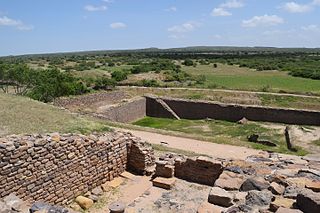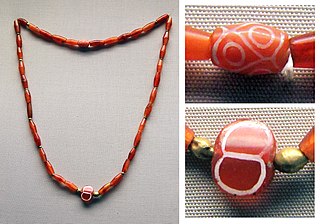
Harappa is an archaeological site in Punjab, Pakistan, about 24 km (15 mi) west of Sahiwal. The Bronze Age Harappan civilisation, now more often called the Indus Valley Civilisation, is named after the site, which takes its name from a modern village near the former course of the Ravi River, which now runs 8 km (5.0 mi) to the north. The core of the Harappan civilization extended over a large area, from Gujarat in the south, across Sindh and Rajasthan and extending into Punjab and Haryana. Numerous sites have been found outside the core area, including some as far east as Uttar Pradesh and as far west as Sutkagen-dor on the Makran coast of Baluchistan, not far from Iran.

The 3rd millennium BC spanned the years 3000 through 2001 BC. This period of time corresponds to the Early to Middle Bronze Age, characterized by the early empires in the Ancient Near East. In Ancient Egypt, the Early Dynastic Period is followed by the Old Kingdom. In Mesopotamia, the Early Dynastic Period is followed by the Akkadian Empire. In what is now Northwest India and Pakistan, the Indus Valley civilization developed a state society.

The Indus Valley Civilisation (IVC), also known as the Indus Civilisation was a Bronze Age civilisation in the northwestern regions of South Asia, lasting from 3300 BCE to 1300 BCE, and in its mature form 2600 BCE to 1900 BCE. Together with ancient Egypt and Mesopotamia, it was one of three early civilisations of the Near East and South Asia, and of the three, the most widespread. Its sites spanned an area from much of Pakistan, to northeast Afghanistan, and northwestern India. The civilisation flourished both in the alluvial plain of the Indus River, which flows through the length of Pakistan, and along a system of perennial monsoon-fed rivers that once coursed in the vicinity of the Ghaggar-Hakra, a seasonal river in northwest India and eastern Pakistan.

Rakhigarhi or Rakhi Garhi is a village and an archaeological site belonging to the Indus Valley civilisation in Hisar District of the northern Indian state of Haryana, situated about 150 km northwest of Delhi. It was part of the mature phase of the Indus Valley Civilisation, dating to 2600-1900 BCE. It was among the largest settlements of the ancient civilisation, though most of it remains unexavated. The site is located in the Ghaggar-Hakra River plain, some 27 km from the seasonal Ghaggar river.

Dholavira is an archaeological site at Khadirbet in Bhachau Taluka of Kutch District, in the state of Gujarat in western India, which has taken its name from a modern-day village 1 kilometre (0.62 mi) south of it. This village is 165 km (103 mi) from Radhanpur. Also known locally as Kotada timba, the site contains ruins of a city of the ancient Indus Valley civilization. Earthquakes have repeatedly affected Dholavira, including a particularly severe one around 2600 BC.
Sutkagan Dor is the westernmost known archaeological site of the Indus Valley civilization. It is located about 480 km west of Karachi on the Makran coast near Gwadar, close to the Iranian border, in Pakistan's Baluchistan Province. The site is near the western bank of the Dasht River and its confluence with a smaller stream, known as the Gajo Kaur. It was a smaller settlement with substantial stone walls and gateways.
Lakhan-jo-daro is an archeological site and one of the largest cities of the Indus Valley civilization. It is located within an industrial zone on the outskirts of the modern city of Sukkur and situated at the distance of mere 75 kilometers from another major city of its contemporary era, Mohenjo Daro. It covers an expanse of more than 300 hectares.
Kuntasi is an archaeological site which is identified as a port belonging to the Indus Valley civilization. This site is located on the right bank of Phulki River, about 3 km south-east of Kuntasi village and 30 km from Morbi in Maliya taluka of Morbi District in Gujarat state of India. It is five km inlandward from present shore line. It was first reported by P. P Pandya and later thoroughly explored by Y. M. Chitalwala. The excavations revealed two periods of occupation. Period I is assigned to the Mature Harappan phase and the Period II is assigned to the Late Harappan phase. This site was identified as a jetty and a manufacturing centre.

The Rann of Kutch is a large area of salt marshes that span the border between India and Pakistan. It is located in Gujarat, India, and in Sindh, Pakistan. It is divided into the Great Rann and Little Rann.
Mandi is a village in the Muzaffarnagar district of Uttar Pradesh, India. It is located about 200 km northeast of Delhi. It is notable for the discovery and looting of an ancient treasure trove by villagers in June 2000. The treasure is believed to have been from the Indus Valley civilisation period. It is known as "Mandi treasure" or "Mandy hoard".

The ancient Indus Valley Civilization in South Asia, including current day's Pakistan and north India, was prominent in infrastructure, hydraulic engineering, and had many water supply and sanitation devices that are the first known examples of their kind.
The Companions of the Rass, also known as the People of the Well or the People of Ar-Rass, were an ancient community, who are mentioned in the Qur'an. The Qur'an provides little information concerning them other than to list them with other communities, including ʿĀd, Thamud, the People of Noah and others; the Qur'an groups all these communities together as nations who went astray and were perished for their sins. Muslim scholars related that the Companions of the Rass were a community in the Azerbaijan region. The root meaning of rass is a well or water pit, but some scholars have stated that Rass was the name of a river or the city itself. It is speculated that modern Aras River is ar-Rass.
Kerala-no-dhoro(કેરળ-નો-ઢોરો), also known as Padri, is an archaeological site in Gujarat, India. Belonging to the Indus Valley civilisation, it is located on the southern coast of Kathiawar region. Dating from 3699-3792 B.C. known as Padri Culture or Early Harappan period a part of Sorath Harappan, Indus Valley culture.
Pabumath is an Indus Valley civilisation archaeological site near Suvai village in Rapar Taluka of Kutch district, Gujarat, India.
Ravindra Singh Bisht is an Indian archaeologist, known for his scholarship on Indus valley civilization and efforts to conserve Indian national monuments. He was honoured by the Government of India, in 2013, by bestowing on him the Padma Shri, the fourth highest civilian award, for his contributions to the field of archaeology.
Jagat Pati Joshi is an Indian archaeologist who discovered the Indus Valley sites of Dholavira and Surkotada. Joshi served as Director General of the Archaeological Survey of India (ASI) from 1987 to 1990.

Etched carnelian beads, or sometimes bleached carnelian beads, are a type of ancient decorative beads made from carnelian with an etched design in white, which were probably manufactured by the Indus Valley civilization during the 3rd millennium BCE. They were made according to a technique of alkaline-etching developed by the Harappans, and vast quantities of these beads were found in the archaeological sites of the Indus Valley civilization. They are considered as an important marker of ancient trade between the Indus Valley, Mesopotamia and even Ancient Egypt, as these precious and unique manufactured items circulated in great numbers between these geographical areas during the 3rd millennium BCE, and have been found in numerous tomb deposits.
Shambhudan Gadhvi is a former master clerk and amateur geologist from Gujarat who discovered the Indus valley site of Dholavira in the early 1960s.